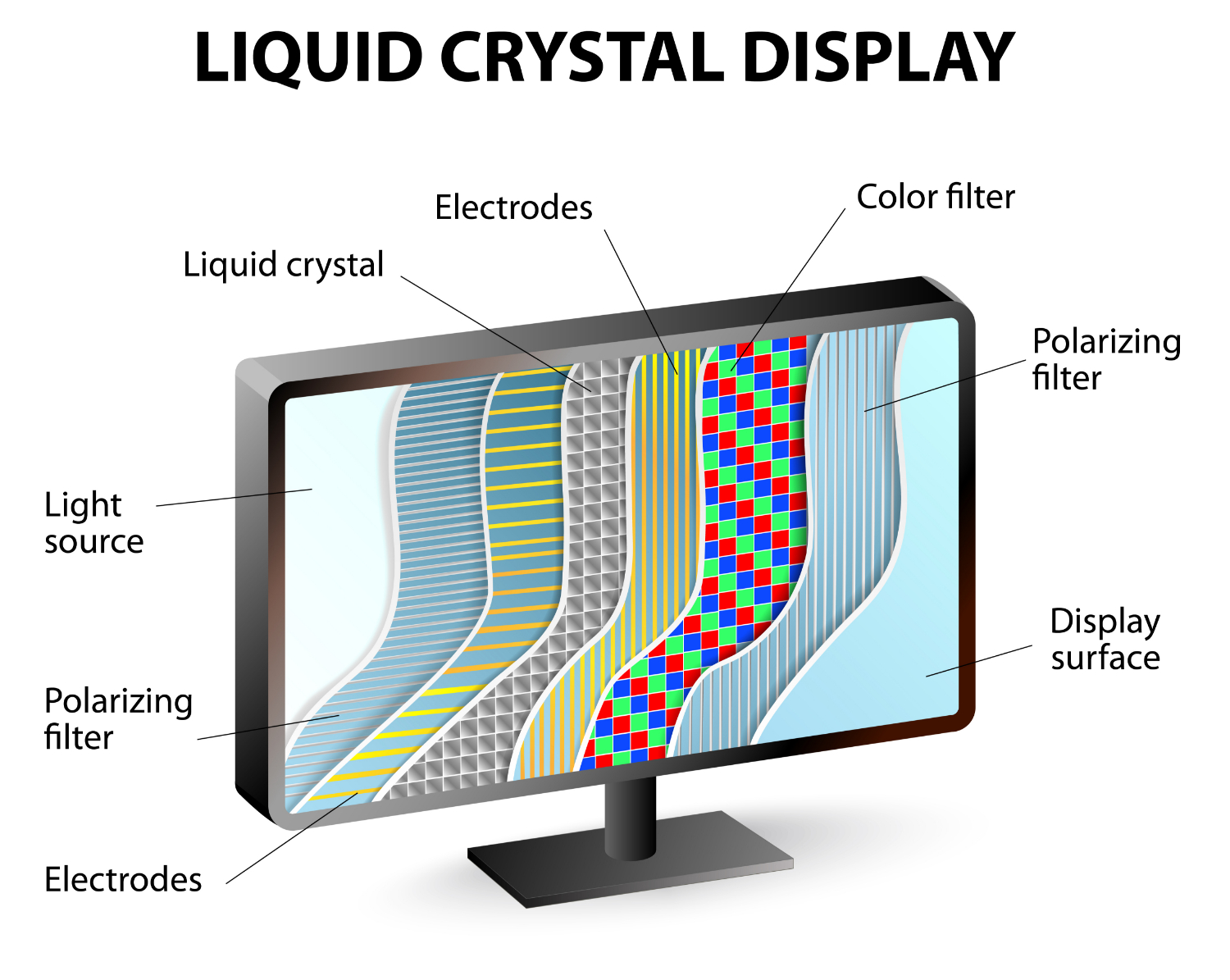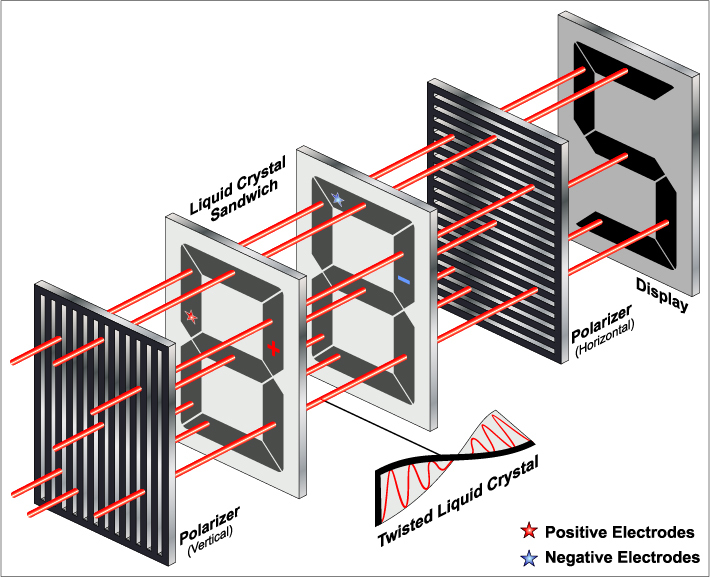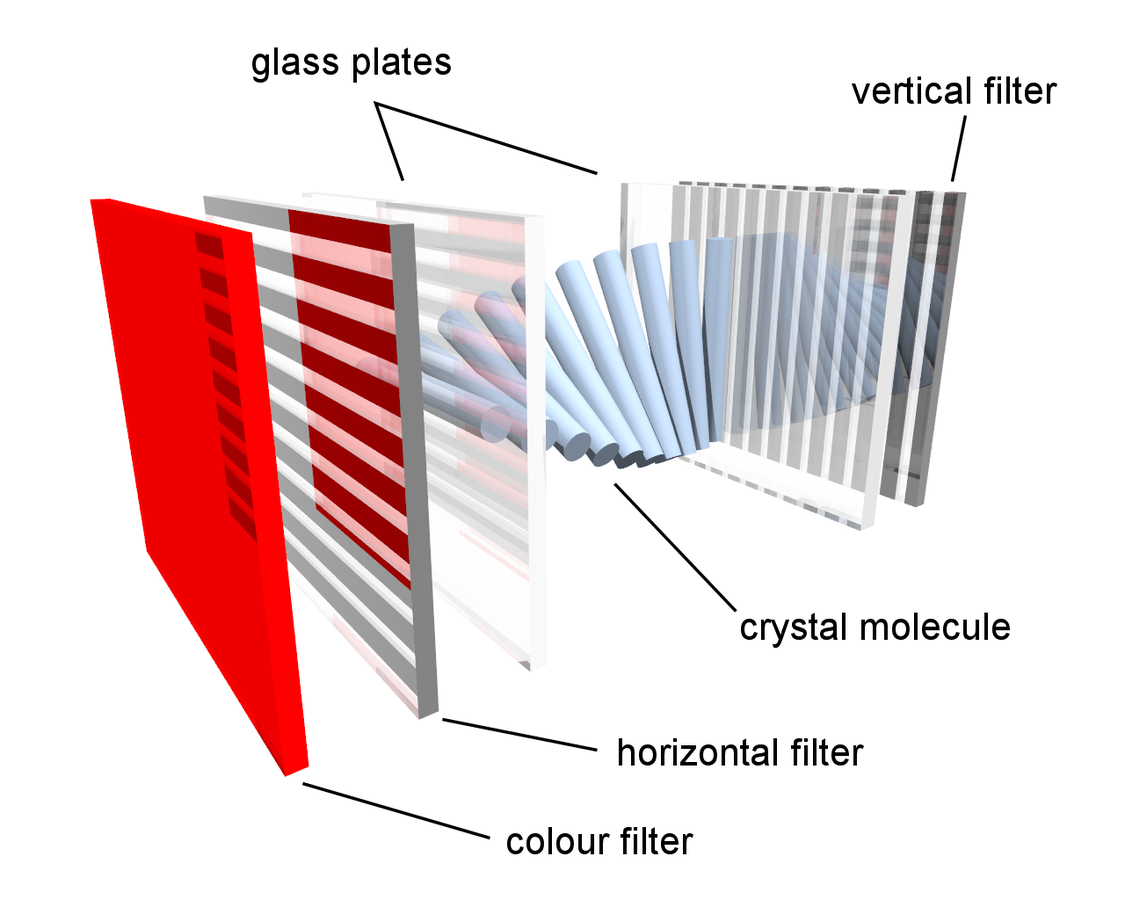LCD v. LED v. OLED: Understanding Different Display Panel Types
There’s a variety of display panel out there and even more on the way. But looking at all the different types of panels can be baffling. They come in various acronyms, and many of those acronyms are confusingly similar. How do LCD, LED and OLED compare? What about the different types of LCD panels? And how do these different technologies impact your viewing experience for things like gaming? To help, we’ve created this guide so you can gain a firm understanding of today’s display panel technology and which features really matter.
LCD Panel Types
The first type of panels we’ll cover are LCD (liquid crystal display) panels. The main thing to understand about LCD panels is that they all use a white backlight (or sidelight, etc.). They work by shining a bright white light into your eyes, while the rest of the panel is for changing this backlight into individual pixels.
Polarization
LED stands for light-emitting diode. You’ll often see LCD panels that are LED, but that doesn’t necessarily mean much when choosing an LCD. LED is just a different type of backlight compared to the old cold cathode backlights. While you could congratulate yourself on not using mercury, which is found in cathodes, at this point all LCDs use LED backlights anyway.
The second thing to understand is that LCDs take advantage of a phenomena known as polarization. Polarization is the direction in which the light wave is oscillating, or swinging back and forth at the same speed. Light comes out of the backlight unpolarized. It then passes through one polarizer, which makes all the light oscillate the same way.
Then there’s the “liquid crystal” part. A liquid crystal in this case is a crystal structure that can change the polarization of light passing through it. A liquid crystal in the rest, or off, state is arranged to not change the polarization of the light. This means that when the light reaches a second polarizer, oriented oppositely from the first polarizer, all the light is blocked. But when you apply a voltage, you turn the liquid crystal into some percentage of an “on” state. This then changes a percentage of the polarization of the light passing through to meet the orientation of the second polarizer, allowing it to pass through and become visible to your eye.
Now you have an on and off (and between) switch for light. To produce color all that’s needed is three color filters, red, green and blue, that block all light other than that color from coming through. The difference between different types of LCD panels is mostly in how this in-between liquid crystal part works.
Get Tom's Hardware's best news and in-depth reviews, straight to your inbox.
So without further ado, here the types of LCD panels:
TN Panels
TN stands for twisted nematic. These were the first LCD panels, and the tech behind them dates back to the 1980s. With TN panels, once the backlight is polarized into one direction, it enters the liquid crystals. Depending on the on or off (or in between) state, this crystal can twist polarization of the light 90°, thus matching the orientation of the second polarizer and letting it through. Or, the crystal can align itself with the first polarizer, and, subsequently, the second polarizer will block the light.
TN Panel Pros and Cons
This design allows for fast response times (the time between the panel getting the frame it’s supposed to display and actually displaying it). It also allows for fast refresh rates. Consequently, TN panels are the only 240 hertz (Hz) gaming monitors available right now.
TN panels are cheap but suffer from poor viewing angles due to the “twist” only being aligned in one direction for viewing the panel straight on. They can also have poor color and contrast due to this twist mechanism not being the most precise or accurate.
VA Panels
VA stands for vertical alignment, again referring to the crystal alignment. These came about in the 1990s. Instead of using liquid crystals to twist a light’s polarization, a VA panel’s liquid crystals are aligned either perpendicular (vertical to) or parallel (horizontal to) the two polarizers. In the off state, the crystals are perpendicular to the two opposing polarizers. In the on state, the crystals begin to align horizontally, changing the polarization to match the second polarizer and allowing the light to go through the crystals.
VA Panel Pros and Cons
This structure produces deeper blacks and better colors than TN panels. And multiple crystal alignments (shifted a bit off axis from each other) can allow for better viewing angles compared to TN panels.
However, VA panels come with a tradeoff, as they are often more expensive than TN panels and tend to have lower refresh rates and slower response times than TN panels. Consequently, you won’t see quite as many VA panel gaming monitors.
IPS Panels
IPS stands for in-plane switching. These panels debuted after TN panels in the mid-1990s. The crystals are always horizontal to the two polarizers and twist 90° horizontally to go from off to on. Part of this design requires the two electrodes (which apply current to the liquid crystal to change its state) to be on the same glass substrate, instead of aligned with each other on the sandwiching glass substrates above and below the crystal (as in other types of LCDs). This, in turn, blocks a bit more light than both TN and VA panels.
IPS Panel Pros and Cons
IPS panels have the best viewing angles and colors of any LCD monitor type, thanks to its crystal alignment always lining up with the viewer. And while they don’t offer as fast a response time or refresh rate as TN panels, clever engineering has still gotten them to 144hz, and with nice viewing angles you’re not necessarily going wrong with an IPS gaming panel.
However, they also tend to be a bit less bright due to their design blocking off a bit more of the backlight.
Quantum Dots
How do LCD panels go about reaching HDR brightness when incorrect polarization and color filters block so much light?The answer is quantum dots. These clever little things are molecules that absorb light and then re-emit that light in the color you engineered them to.
Today’s quantum dot layers usually go between a blue backlight and the polarization step, and are often used to produce red and green that more closely matches the color filters, so more light passes through them. This allows more of the backlight to come through instead of being blocked by the color filters, it can also reduce crosstalk, or colors slipping through the wrong subpixel, ensuring better colors of LCDs.
Other uses of quantum dots are being tried, however. One promising one is using QD molecules to replace the color filters entirely, allowing even more light through. Because LCD backlights produce more light than OLED panels (more on those below), this would allow LCDs to become the brightest displays around.
What quantum dot displays don’t do, however, is affect refresh rates, switching times et cetera. Being passive, they sit there and affect color and brightness only. But really, how fast do you need your refresh rate to go anyway?
Choosing an LCD Panel
Motion blur/ghosting can be a result of how long an image takes to switch from one to another and how long an image is displayed on screen (persistence). But both of these phenomena differ greatly between individual LCD panels regardless of underlying LCD tech. And both are often better controlled by higher refresh rates, rather than clever panel engineering, at least for LCD displays.
Choosing an LCD panel based on underlying LCD tech should be more about cost vs desired contrast, viewing angles and color reproduction than expected blur, or other gaming attributes. Maximum refresh rate and response time should be listed in any respectable panel’s specs. Other gaming tech, such as strobe, which flashes the backlight on and off quickly to reduce persistence, may not be listed at all and is not part of the underlying type of LCD used. For that kind of info you’ll have to check the detailed reviews here on our site.
And for more helpful advice on picking a PC monitor, be sure to check out our monitor buying guide.
OLED Panels
OLED, or organic light emitting diode, panels, are different from LCDs. There are no polarization tricks here. Instead, each pixel (or subpixel of red, green, or blue) lights itself up as a voltage is applied to a giant complex molecule called, yep, an organic light emitting diode. The color emitted is dependent on the molecule in question, and brightness is dependent on the voltage applied. OLEDs can reach HDR brightness because their molecules put out the right colors to begin with without being blocked.
OLED Panel Pros and Cons
Due to its approach to color and brightness, OLEDs have great contrast ratios. There’s no need to block a backlight, so there’s no worries about light bleeding through. Blacks are very black, and colors look great. OLEDs can also strobe, or flash off and on quickly to lower persistence. They can also use a trick called rolling scan.This turns blocks of the screen on and off one at a time, from top to bottom in a roll. This is all done as the image is sent to the screen, which cuts down on persistence blur a lot. This is why every major VR headset that can afford it uses OLED panels today.
OLEDs can even be flexible, so look for them to show up in tomorrow’s promised bendable and foldable phones and tablets.
Unfortunately, that’s where the advantages of OLED end. Refresh rates of OLED panels have never surpassed about 90Hz. And they’re quite expensive. A large part of that $1,000 iPhone X price is due to its OLED display. The current molecules used in OLEDs also degrade relatively quickly over time, especially those used for the color blue, making the screen less and less bright.
OLEDs were also supposed to use less power than LCDs, but newer, giant OLED molecules that take less voltage to turn on have yet to appear. And while molecules covering the colors of the P3 HDR gamut are out today, those covering the larger BT.2020 gamut have yet to be found commercially. So OLEDs, while once promising and seemingly the future, have yet to live up to that promise.
MicroLED: The Future?
A relevant question: If our fastest gaming displays are 240Hz TN panels now, just how fast do we need to go anyway? Well, a 2015 study places maximum human perception at 500Hz. So from that perspective, we’re halfway there. But that’s halfway there with today’s HDR, and not in lightfield 3D, or other possible advancements. And mobile devices could always use displays that take up less power.
In other words, in order to get fancy 3D effects, or much higher brightness, or any other desirable features, a different, new type of panel may be required. MicroLED tech is one such technology; think of it as OLED without the organic part and with the potential to improve contrast, response times and energy usage over standard LED panels. If you want to know more you can go here, but the real takeaway is that MicroLEDs work almost exactly like OLEDs.
Samsung, LG and Apple are currently researching MicroLEDs, but only time will tell if it becomes a popular standard.
MORE: Best Gaming Monitors
MORE: How We Test Monitors
MORE: All Monitor Content
-
RAZ3RX Can someone elaborate on the little note about the HDR colorspaces? My LG OLED acquired nearly 2 years ago has Dolby Vision and HDR10 capability. Both of which, if I recall correctly, exceed the BT.2020 spectrum? Also, where is the comparisons of HDR technology in all this? It is only mentioned in the OLED section. The brightness of each technology has a significant impact on the panel being able to pass an HDR standard, as there is the brightness per pixel requirements.Reply -
The author should mention that human vision is continuous and we don't see in refresh rates. The 500Hz means that your brain and body went highwire, probably because you are running from something that's about to eat you, and it's not possible to sustain it for a prolonged period of time. Seeing how human vision works it just shows that spending millions dollars on marketing is indeed worth it. The facts don't matter, they said it makes one better, so it must be so.Reply
-
BryanFRitt "Humans perceive flicker artifacts at 500?Hz"Reply
Skip 500Hz and go for positive integer multiples of 600Hz
since 600Hz matches nicely as a multiple of most video sources
factor(600)=2^3 * 3^1 * 5^2
15*40=600, 24*25=600, 25*24=600, 30*20=600, 50*12=600, 60*10=600, 100*6=600, 120*5=600, ...
oh wait... "several viewers reported visibility of flicker artifacts at over 800?Hz"
might have to go for 1200Hz now..., or if you believe in doing everything at least 2x just to be sure then 2400Hz.
Anyway the true question is always "is the difference worth the cost?", not can it be measured that you can see the difference in some way, although this knowledge can be helpful in determining rather or not "the difference worth the cost". -
rantoc Choosing an LCD Panel... You mean "Choose PC or Console" up there with Ideal Image vs Blurred mess? =PReply -
NinjaNerd56 I have an LG LED UHD set (55) in the bedroom, connected to an Apple TV 4K and TiVo Bolt 4K DVR. Looks good...calibration is close to the suggested ones at rting.com for this set.Reply
OTOH, I have a new Sony A8F OLED set (65) in the living room home theatre setup, also with an Apple TV and TiVo box as well as a Sony BR player.
The Sony replaced a Panasonic VT60 plasma set recently...and is stupidly good. Again, followed MOST of the suggestions from rtings.com and a couple of others, and it is the best TV I’ve ever owned.
I have an AOC IPS display (27) for my PCs (KVM setup) and while only 1080P, it looks quite nice married to a GTX1060 on my main gaming tower.
All have their merits. For pure movie/TV content, the Sony is the clear choice and winner. For everything else...I don’t much care.
I think my next monitor will be either OLED or microLED...30-34 inch.
LED is just “nice, but...” or as I like to say, “For a fat girl, you don’t sweat much, do ya?” -
Dantte MicroLED... First, lets define what is a "MicroLED", and no, your WIKI that you linked does it no justice.Reply
LED displays exist today and are commercially available. Planar has one of the smallest pitch displays at .7mm, and many others exist. Is this what you mean by "MicroLED", if not, when does it become "Micro..."? -
nitrium Reply
Good luck on getting that non-existent OLED monitor. Dell recently cancelled, AFAIK, the only OLED monitor in any manufacturers pipeline. What the article above doesn't mention is that OLED suffers from burn in - i.e. if you retain the same image too long it becomes a permanent ghost. This is not a problem for TVs or mobile phones, since the entire image regularly changes (+ mobiles are rarely left on for very long anyway). For a desktop monitor not so much - i.e. you will see the Windows taskbar ghosted onto everything (e.g. games and video) before very long.21267405 said:I think my next monitor will be either OLED or microLED...30-34 inch.
-
dabeargrowls I love my OLED. I can never go back to anything else after experiencing it. Its on my Alienware 13R3 laptop. Yes, the screen is small compared to other but man its so awesome. As for 90hz max... ohh well. Just remember with the current HDMI standard that 99.9% of us have the max you get is 60FPS in UHD. (HDMI limitations, not the TV or the card)Reply




